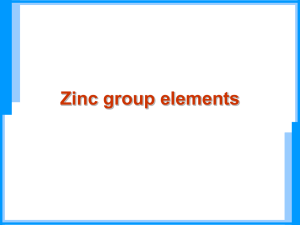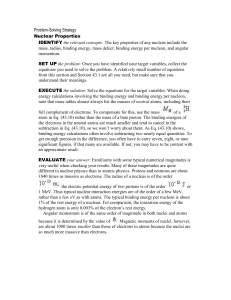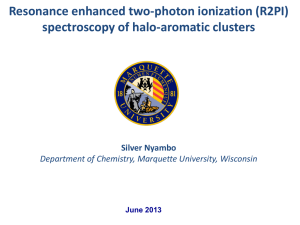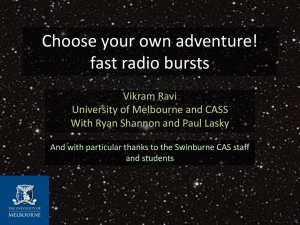Structural characterization of the H 4 B binding pocket
advertisement
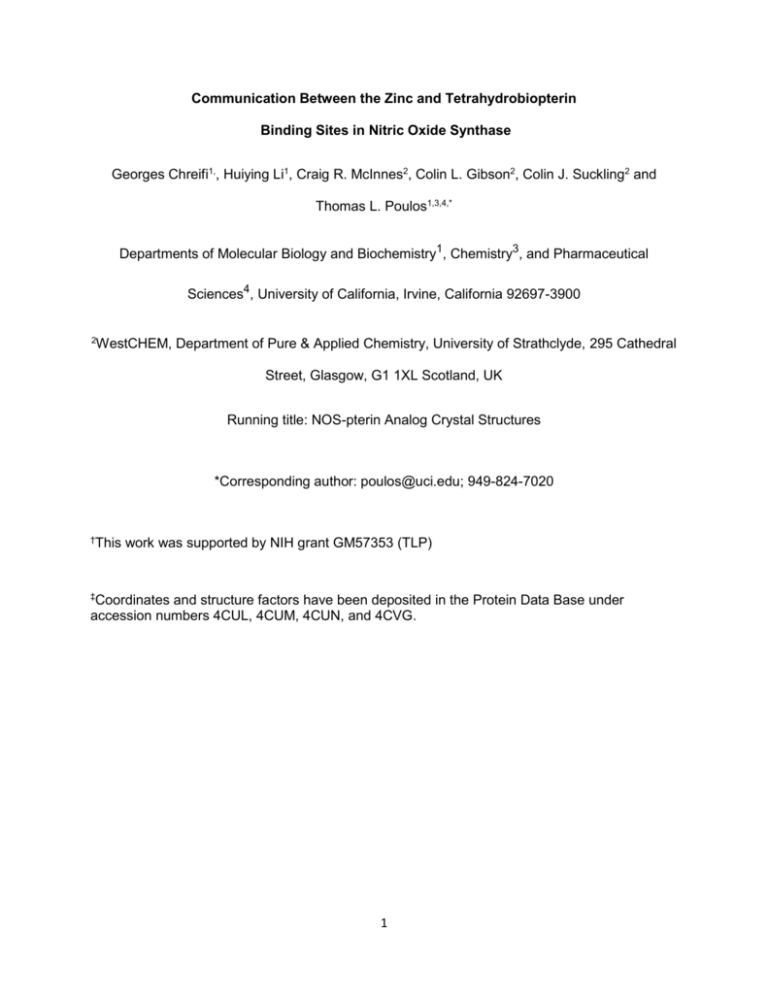
Communication Between the Zinc and Tetrahydrobiopterin Binding Sites in Nitric Oxide Synthase Georges Chreifi1,, Huiying Li1, Craig R. McInnes2, Colin L. Gibson2, Colin J. Suckling2 and Thomas L. Poulos1,3,4,* Departments of Molecular Biology and Biochemistry1, Chemistry3, and Pharmaceutical Sciences4, University of California, Irvine, California 92697-3900 2 WestCHEM, Department of Pure & Applied Chemistry, University of Strathclyde, 295 Cathedral Street, Glasgow, G1 1XL Scotland, UK Running title: NOS-pterin Analog Crystal Structures *Corresponding author: poulos@uci.edu; 949-824-7020 † This work was supported by NIH grant GM57353 (TLP) ‡ Coordinates and structure factors have been deposited in the Protein Data Base under accession numbers 4CUL, 4CUM, 4CUN, and 4CVG. 1 ABSTRACT The nitric oxide synthase (NOS) dimer is stabilized by a Zn2+ ion coordinated to four symmetry related Cys residues exactly along the dimer 2-fold axis. Each of the two essential tetrahydrobiopterin (H4B) molecules in the dimer interacts directly with the heme, and each H4B molecule is about 15 Å from the Zn2+. We have solved the crystal structures of the bovine endothelial NOS (eNOS) dimer oxygenase domain bound to three different pterin analogs which reveal an intimate structural communication between the H4B and Zn2+ sites. The binding of one of these compounds, 6-Acetyl-2-amino-7,7-dimethyl7,8-dihydro-4(3H)-pteridinone, 1, to the pterin site and Zn2+ binding are mutually exclusive. Compound 1 both directly and indirectly disrupts hydrogen bonding between key residues in the Zn2+ binding motif, resulting in destabilization of the dimer and a complete disruption of the Zn2+ site. Addition of excess Zn2+ stabilizes the Zn2+ site at the expense of weakened binding of 1. The unique structural features of 1 that disrupt the dimer interface are extra methyl groups that extend into the dimer interface and force a slight opening of the dimer thus resulting in disruption of the Zn2+ site. These results illustrate a very delicate balance of forces and structure at the dimer interface which must be maintained to properly form the Zn 2+, pterin, and substrate binding sites. 2 Mammalian nitric oxide synthases (NOS) require the co-factor (6R)-5,6,7,8-tetrahydrobiopterin (H4B)1 in order to convert L-arginine to L-citrulline and nitric oxide2, 3, an important second-messenger molecule in neural and cardiovascular systems4. The mammalian NOS enzyme family consists of three isoforms, neuronal NOS (nNOS), inducible NOS (iNOS), and endothelial NOS (eNOS)5. Each isoform is active only as a homodimer because the pterin binding site locates right at the dimer interface, therefore, monomeric NOS does not bind H4B and substrate6. The dimer interface is formed between two Nterminal heme binding oxygenase domains which is further stabilized by the coordination of a Zn2+ ion ligated to two cysteine thiols from each subunit (ZnS4)7, 8 (Fig 1). The role of H4B is as a redox active oneelectron donor that activates the heme-bound O2, resulting in the formation of an H4B radical9. This radical is then re-reduced by obtaining an electron from the ferrous NO complex generated at the end of the catalytic reaction, thus allowing the release of NO from the ferric heme10, 11. All NOS isoforms share a strikingly similar pterin binding pocket with comparable H4B binding affinities, and co-factor and substrate binding events have been shown to synergistically stabilize the NOS dimer12-14. Low temperature SDSPAGE and urea dissociation studies indicate that the relative dimer strengths of the three mammalian NOS isoforms are eNOS > nNOS > iNOS and that the role of H4B in dimer stability is less critical in eNOS15, 16. The structural basis for this disparity, however, is not yet fully understood. One way of exploring the relationship between dimer stability and H4B binding is to investigate the pterin binding pocket using various pterin analogs. Moreover, inactive pterin analogs could potentially serve as NOS inhibitors12, 17-19 and have proven useful in probing the function of H4B20-23. In this study we have determined the crystal structures of three novel pterin compounds (Fig. 2) analogous to H4B bound to eNOS which has unexpectedly provided important insights on the intimate connection between the Zn2+, pterin, and substrate binding sites. MATERIALS AND METHODS Protein Expression and Purification 3 The bovine holo-eNOS pCWori construct was transformed into Escherichia coli BL21(DE3) cells already containing the calmodulin plasmid, and were then plated onto LB agar with ampicillin (100 μg/mL) and chloramphenicol (35 μg/mL). E. coli cells inherently lack the machinery to synthesize H 4B, ensuring that eNOS would remain H4B free. A single colony was used to inoculate each 5 mL of LB starter culture (100 μg/mL ampicillin and 35 μg/mL chloramphenicol). The culture was incubated for 8 hrs at 37°C and 220 rpm agitation. Each liter of TB medium (100 μg/mL ampicillin and 35 μg/mL chloramphenicol) was inoculated with 2 mL of LB starter culture. The cells were grown at 37 °C with agitation at 220 rpm until the OD (600 nm) reached 1.0 - 1.2. Protein expression was then induced by adding 0.5 mM isopropyl βD-thiogalactoside and 0.4 mM δ-aminolevulinic acid. A new dose of ampicillin and chloramphenicol were also added and cell growth was resumed at 25 °C and 100 rpm for 24 hrs. The cells were then harvested by centrifugation and stored at - 80 °C. Cells were thawed and resuspended by stirring for 3 hrs at 4°C in buffer A (50 mM sodium phosphate, pH 7.8, 10% glycerol, 0.5 mM L-Arg, 5 mM β-mercaptoethanol, 0.1 mM PMSF and 200 mM NaCl). The following protease inhibitors were added to buffer A before lysis: trypsin inhibitor (5 g/mL), pepstatin A and leupeptin (1 μg/mL each). Cells were lysed by passing through a microfluidizer at 18k psi (Microfluidics International Co). The soluble fraction was isolated by centrifugation at 17,000 rpm and 4°C for 1 hr. The crude extract was then loaded onto a Ni2+-nitrilotriacetate column pre-equilibrated with 10 bed volumes of buffer A. After loading of the crude extract the column was washed with 10 bed volumes of 10 mM imidazole in buffer A before elution with a 10 to 200 mM imidazole linear gradient in buffer A. Colored fractions were pooled and loaded onto a 2’,5’-ADP Sepharose column pre-equilibrated with buffer B (50 mM Tris-HCl, pH 7.8, 10% glycerol, 5 mM β-mercaptoethanol, 0.1 mM PMSF, 0.5 mM L-Arg and 200 mM NaCl). The column was then washed with 10 bed volumes of buffer B and then eluted with 10 mM NADP+ in buffer B. Colored fractions were pooled and concentrated in a 30,000 molecular weight cut-off Amicon concentrator at 4°C. The eNOS heme domain used for crystallization was generated by limited trypsinolysis: a 20:1 weight ratio of eNOS:trypsin was used with a 1 hr incubation at 25°C. The digested sample was then loaded onto a Superdex 200 column (HiLoad 26/60, GE Healthcare) controlled by an FPLC system and pre-equilibrated with buffer B in order to separate the heme domain and flavin- 4 containing fragment generated by the trypsin digest. Fractions were pooled according to a spectral ratio A280/A395 < 1.7, and sample homogeneity was determined by SDS-PAGE. Synthesis of H2B analogs Preparation of the pterin compounds 6-acetyl-2-amino-7,7-dimethyl-7,8-dihydro-4(3H)-pteridinone (1 in Fig. 1) as well as 2-amino-9a-methyl-6,7,8,9,9a,10-hexahydrobenzo[g]pteridin-4(3H)-one (2), and 2-amino-9a-methyl-8,9,9a,10-tetrahydrobenzo[g]pteridine-4,6(3H,7H)-dione (3) used in this study has been previously described24, 25. Crystal Preparation All eNOS heme domain samples were prepared for crystallization by concentrating to 12 mg/mL in buffer B using a 30,000 MWCO Amicon concentrator. Co-crystallization was done by combining protein with 5 mM cofactor and 5 mM L-arginine. Crystals were grown at 4°C in 18 - 20% PEG 3350 (w/v), 250 mM magnesium acetate, 100 mM cacodylate, pH 6.25, and 5 mM tris(2-carboxyethyl)phosphine (TCEP) in a sitting-drop vapor diffusion setup. Freshly grown crystals were passed stepwise through a cryoprotectant solution containing 20% PEG 3350, 10% glycerol (v/v), 10% trehalose (w/v), 5% sucrose (w/v), 5% mannitol (w/v), 10 mM cofactor, and 5 – 10 mM L-Arg for 4-6 hrs at 4 °C before being flash cooled with liquid nitrogen. X-ray Diffraction Data Collection, Processing, and Structure Refinement Cryogenic (100 K) X-ray diffraction data were collected remotely at Stanford Synchrotron Radiation Lightsource (SSRL) using the data collection control software Blu-Ice26 and a crystal mounting robot. An ADSC Q315r CCD detector at beamline 7-1 or a Mar325 CCD detector at beamline 9–2 was used for data collection. Raw data frames were indexed, integrated, and scaled using HKL200027. The binding of H4B cofactors was detected by the initial difference Fourier maps calculated with REFMAC28. The inhibitor molecules were then modeled in COOT 29 and refined using REFMAC. Water molecules were added in REFMAC and checked by COOT. The TLS30 protocol was implemented in the final stage of refinements with each subunit as one TLS group. The refined structures were validated in COOT 5 before deposition in the RCSB Protein Data Bank. The crystallographic data collection and structure refinement statistics are summarized in Table 1 with PDB accession codes included. RESULTS AND DISCUSSION Structural characterization of the H4B binding pocket As shown in Fig. 2, the three dihydropterin analogs retain the ring structure of H4B and only introduce variations in the side chain. Fig. 3 shows the electron density of the three dihydropterin analogs bound to eNOS. Compound 1 (Fig. 3A) exhibits the strongest and most well defined electron density. As expected from its structural similarity to H4B compound 1 fits into the pterin binding pocket quite well, maintaining most of the interactions found with H4B: the - stacking with W449, the H-bonds from its 2aminopyrimidine nitrogens to the heme propionate A, the H-bond from O4 to R367, and the Van der Waals contacts with aromatic residues of the other subunits (W76 and F462). Therefore, it is not surprising that the tetrahydro form of 1 can support the conversion of L-arginine to NO in nNOS31. However, the two additional H-bonds from the dihydroxypropyl side chain of H4B to the carbonyls of S104 and F462 are lost in 1. Unique to 1 is the close contact from one of its methyl groups at the C7 position to the W447 side chain of the other subunit. Both 2 and 3 at the dihydro oxidation state introduce a third cyclohexane ring to replace the H4B side chain. Although the third ring is tolerated by the pterin binding pocket the extra methyl group at C7 may generate steric clashes with the protein. As a result, 2 (Fig. 3B) and 3 (Fig. 3C) exhibit weaker electron density. Crystals of the eNOS-3 complex diffract poorly which we have found correlates well with poor ligand binding. Since 3 is structurally similar to 2 and differs only in the carbonyl O atom on the cyclohexane ring, the additional steric crowding of this oxygen in 3 very likely accounts for why this pterin analog binds more poorly. Overall, the inability of the three pterin analogs to form hydrogen bonds with S104 and F462 and the steric clashes from their protruding methyl groups may attribute to poorer binding affinity compared to the tight nanomolar binding affinity with the native pterin, H4B. Disruption of the Zn2+ binding site 6 As shown in Fig. 4, a single Zn2+ ion is situated at the dimer interface where it is tetrahedrally coordinated by symmetry related Cys residues along the dimer axis. The Zn2+ is about 15 Å from the center of the pterin binding pocket in both subunits A and B of the dimer. Quite unexpectedly we found that the binding of 1 completely disrupts the Zn2+ binding region, as evidenced by a total lack of electron density for residues 91-109 and the Zn2+ (Fig. 4A). It has been known for some time that both Zn2+ and H4B contribute to dimer stability8, 32, 33, but this is the first indication that there is a relatively long range communication between these two sites. To probe whether or not the binding of 1 and Zn2+ are mutually exclusive, we soaked crystals of the eNOS-1 complex in a cryoprotectant solution supplemented with 50 μM Zn acetate. The crystal structure shows that Zn2+ binding is restored (Fig. 4D) while the electron density for 1 and the substrate, L-Arg, are poorly defined (Fig. 3D). We next soaked crystals in a more moderate 20 μM Zn acetate concentration. In this case, 1 and L-Arg bind well, but the Zn2+ site is disordered (data not shown). In contrast, binding of 2 and 3 do not interfere with the Zn2+ binding (Figs. 4B and 4C). How does the pterin site communicate with the Zn 2+ site? These results clearly show that there is a strong long range communication between the Zn 2+, pterin, and substrate binding sites. In order to explain why, we next carried out a detailed comparison between the eNOS-1 complex with a disordered Zn2+ and the fully ordered eNOS structure with H4B bound. By superposition of the α-carbon backbone of chains A (Fig. 5B), we see that chain B has shifted away by a significant distance. For comparison, we next superposed H4B-bound to H4B-free eNOS structures (Fig. 5A) and did the same for 2 (Fig. 5C) and 3 (Fig 5D) bound structures. In these cases chain B does not move significantly relative to chain A. For consistency, we superposed the α-carbon backbone of chain B and observed a similar shift in chain A. To further quantify the observation we calculated the RMS deviations of chains A and B for residues ranging from 121 to 482 in each pair of structures. For eNOS-1 complex superposed based only on chain A with an H4B bound eNOS reference structure (PDB code 9NSE) the rms deviation of chain B is 1.23 Å, compared to 0.27 - 0.44 Å calculated with the same method against the same reference structure for either an H4B-free structure or other pterin analog structures that do not disrupt the Zn2+ site (Table 2). 7 A close examination of eNOS-1 structure reveals that the reason why chain B moves away from chain A is due to the methyl groups on C7 of 1 (Fig. 6B). Accommodating these methyl substituents forces W447 of chain B to shift away from chain A. The shift of W447 is not merely absorbed locally, but instead it induces a global change in the entire chain B as a rigid body. The repulsion between the methyl group of 1 and W447 occurs in a symmetrical manner in both subunits that results in the slight opening up of the dimer interface. The widened dimer interface causes disruption of key backbone contacts between the Cys-bearing Zn2+ binding hair-pin fragment (residues 95 – 102) which includes contacts between C101 and N468 (Fig. 6B). Loss of those key interactions leads to the total disordering of the Zn 2+ binding site. Comparatively, the H4B-free eNOS structure (Fig. 6A), and those in complex with 2 (Fig. 6C) and 3 (Fig. 6D) show practically no shift of W447. The extra methyl group in 2 and 3 is not directly pointing to W477 causing no disruption of the dimer interface. In the same way, we also compared the H 4B-bound eNOS structure to the eNOS-1 complex supplemented with 50 μM Zn2+ giving a restored Zn2+ site and the resulting superposition shows a tighter dimer (Fig. 7A) and a restored W447 position (Fig. 7B), with the expense of weakened binding of 1 (Fig. 3D). What does this communication reveal about the NOS dimer? These results reveal that the eNOS dimer is able to loosen up and expand in order to accommodate 1. The side-effect is that all hydrogen bonding interactions that stabilize the Zn 2+ binding site, mainly the two between N468 and C101, are weakened or lost, as shown in Fig. 6. This effect being compounded on both chains causes a complete disruption of Zn 2+ binding and destabilization of the dimer. Previous studies have shown that eNOS has the strongest dimer compared to nNOS and iNOS16. In order to obtain NOS-pterin complexes, it is necessary to purify NOS in the absence of H 4B and only eNOS, not nNOS, is stable enough without H4B during purification. Two attempts were made to purify nNOS with pterin free buffer or the buffer supplemented with 1, but the protein denatured completely upon trypsinolysis required for generating the heme domain. This very likely reflects the fact that the eNOS dimer is more stable than nNOS: it can survive purification without H4B bound and can bind 1 without disruption of dimer. This also suggests that the combination of inter-subunit contacts attributed to 8 eNOS’ greater dimer strength enable it to survive disruption of the Zn2+ site without complete disruption of the dimer. Summary Even though the importance of H4B in stabilizing the NOS dimer has been known for some time, the present study provides the structural basis for the intimate structural communication between H 4B, Zn2+, substrate binding, and dimer stability. We were fortunate that the additional stability of the eNOS dimer enabled us to probe perturbations at the dimer interface without totally disrupting the dimer which would preclude any detailed crystallographic analysis as in the case of nNOS. It is remarkable that the mere addition of the methyl groups in 1 can have such a dramatic effect on the Zn2+ site. This underscores the exquisite fine-tuning of interactions that stabilize the NOS dimer and the close interdependence of the Zn2+, pterin, and substrate binding sites. 9 References (1) Hevel, J.M., White, K.A., and Marletta, M.A. (1991) Purification of the inducible murine macrophage nitric oxide synthase. Identification as a flavoprotein. J Biol Chem 266, 2278922791. (2) Marletta, M.A. (1993) Nitric oxide synthase structure and mechanism. J Biol Chem 268, 12231-12234. (3) Stuehr, D.J., and Griffith, O.W. (1992) Mammalian nitric oxide synthases. Adv Enzymol Relat Areas Mol Biol 65, 287-346. (4) Forstermann, U., and Sessa, W.C. (2012) Nitric oxide synthases: regulation and function. Eur Heart J 33, 829-837, 837a-837d. (5) Knowles, R.G., and Moncada, S. (1994) Nitric oxide synthases in mammals. Biochem J 298, 249-258. (6) Crane, B.R., Arvai, A.S., Gachhui, R., Wu, C., Ghosh, D.K., Getzoff, E.D., Stuehr, D.J., and Tainer, J.A. (1997) The structure of nitric oxide synthase oxygenase domain and inhibitor complexes. Science 278, 425-431. (7) Raman, C.S., Li, H., Martasek, P., Kral, V., Masters, B.S., and Poulos, T.L. (1998) Crystal structure of constitutive endothelial nitric oxide synthase: a paradigm for pterin function involving a novel metal center. Cell 95, 939-950. (8) Li, H., Raman, C.S., Glaser, C.B., Blasko, E., Young, T.A., Parkinson, J.F., Whitlow, M., and Poulos, T.L. (1999) Crystal structures of zinc-free and -bound heme domain of human inducible nitric-oxide synthase. Implications for dimer stability and comparison with endothelial nitric-oxide synthase. J Biol Chem 274, 21276-21284. 10 (9) Wei, C.C., Wang, Z.Q., Wang, Q., Meade, A.L., Hemann, C., Hille, R., and Stuehr, D.J. (2001) Rapid kinetic studies link tetrahydrobiopterin radical formation to heme-dioxy reduction and arginine hydroxylation in inducible nitric-oxide synthase. J Biol Chem 276, 315-319. (10) Bec, N., Gorren, A.F.C., Mayer, B., Schmidt, P.P., Andersson, K.K., and Lange, R. (2000) The role of tetrahydrobiopterin in the activation of oxygen by nitric-oxide synthase. J Inorg Biochem 81, 207-211. (11) Santolini, J., Meade, A.L., and Stuehr, D.J. (2001) Differences in three kinetic parameters underpin the unique catalytic profiles of nitric-oxide synthases I, II, and III. J Biol Chem 276, 48887-48898. (12) Presta, A., Siddhanta, U., Wu, C., Sennequier, N., Huang, L., Abu-Soud, H.M., Erzurum, S., and Stuehr, D.J. (1998) Comparative functioning of dihydro- and tetrahydropterins in supporting electron transfer, catalysis, and subunit dimerization in inducible nitric oxide synthase. Biochemistry 37, 298-310. (13) Klatt, P., Schmid, M., Leopold, E., Schmidt, K., Werner, E.R., and Mayer, B. (1994) The pteridine binding site of brain nitric oxide synthase. Tetrahydrobiopterin binding kinetics, specificity, and allosteric interaction with the substrate domain. J Biol Chem 269, 13861-13866. (14) List, B.M., Klosch, B., Volker, C., Gorren, A.C., Sessa, W.C., Werner, E.R., Kukovetz, W.R., Schmidt, K., and Mayer, B. (1997) Characterization of bovine endothelial nitric oxide synthase as a homodimer with down-regulated uncoupled NADPH oxidase activity: tetrahydrobiopterin binding kinetics and role of haem in dimerization. Biochem J 323, 159-165. (15) Venema, R.C., Ju, H., Zou, R., Ryan, J.W., and Venema, V.J. (1997) Subunit interactions of endothelial nitric-oxide synthase. Comparisons to the neuronal and inducible nitric-oxide synthase isoforms. J Biol Chem 272, 1276-1282. (16) Panda, K., Rosenfeld, R.J., Ghosh, S., Meade, A.L., Getzoff, E.D., and Stuehr, D.J. (2002) Distinct dimer interaction and regulation in nitric-oxide synthase types I, II, and III. J Biol Chem 277, 31020-31030. 11 (17) Werner, E.R., Pitters, E., Schmidt, K., Wachter, H., Werner-Felmayer, G., and Mayer, B. (1996) Identification of the 4-amino analogue of tetrahydrobiopterin as a dihydropteridine reductase inhibitor and a potent pteridine antagonist of rat neuronal nitric oxide synthase. Biochem J 320, 193-196. (18) Mayer, B., Wu, C., Gorren, A.C., Pfeiffer, S., Schmidt, K., Clark, P., Stuehr, D.J., and Werner, E.R. (1997) Tetrahydrobiopterin binding to macrophage inducible nitric oxide synthase: heme spin shift and dimer stabilization by the potent pterin antagonist 4-aminotetrahydrobiopterin. Biochemistry 36, 8422-8427. (19) Pfeiffer, S., Gorren, A.C., Pitters, E., Schmidt, K., Werner, E.R., and Mayer, B. (1997) Allosteric modulation of rat brain nitric oxide synthase by the pterin-site enzyme inhibitor 4aminotetrahydrobiopterin. Biochem J 328, 349-352. (20) Schmidt, P.P., Lange, R., Gorren, A.C., Werner, E.R., Mayer, B., and Andersson, K.K. (2001) Formation of a protonated trihydrobiopterin radical cation in the first reaction cycle of neuronal and endothelial nitric oxide synthase detected by electron paramagnetic resonance spectroscopy. J Biol Inorg Chem 6, 151-158. (21) Gorren, A.C., Schrammel, A., Riethmuller, C., Schmidt, K., Koesling, D., Werner, E.R., and Mayer, B. (2000) Nitric oxide-induced autoinhibition of neuronal nitric oxide synthase in the presence of the autoxidation-resistant pteridine 5-methyltetrahydrobiopterin. Biochem J 347, 475-484. (22) Riethmuller, C., Gorren, A.C., Pitters, E., Hemmens, B., Habisch, H.J., Heales, S.J., Schmidt, K., Werner, E.R., and Mayer, B. (1999) Activation of neuronal nitric-oxide synthase by the 5-methyl analog of tetrahydrobiopterin. Functional evidence against reductive oxygen activation by the pterin cofactor. J Biol Chem 274, 16047-16051. (23) Hevel, J.M., and Marletta, M.A. (1992) Macrophage nitric oxide synthase: relationship between enzyme-bound tetrahydrobiopterin and synthase activity. Biochemistry 31, 7160-7165. (24) Alhassan, S.S., Cameron, R.J., Curran, A.W.C., Lyall, W.J.S., Nicholson, S.H., Robinson, D.R., Stuart, A., Suckling, C.J., Stirling, I., and Wood, H.C.S. (1985) Specific 12 Inhibitors in Vitamin Biosynthesis .7. Syntheses of Blocked 7,8-Dihydropteridines Via AlphaAmino Ketones. Journal of the Chemical Society-Perkin Transactions 1, 1645-1659. (25) Cameron, R., Nicholson, S.H., Robinson, D.H., Suckling, C.J., and Wood, H.C.S. (1985) Specific Inhibitors in Vitamin Biosynthesis .8. Syntheses of Some Functionalized 7,7-Dialkyl-7,8Dihydropterins. Journal of the Chemical Society-Perkin Transactions 1, 2133-2143. (26) McPhillips, T.M., McPhillips, S.E., Chiu, H.J., Cohen, A.E., Deacon, A.M., Ellis, P.J., Garman, E., Gonzalez, A., Sauter, N.K., Phizackerley, R.P., Soltis, S.M., and Kuhn, P. (2002) Blu-Ice and the Distributed Control System: software for data acquisition and instrument control at macromolecular crystallography beamlines. J Synchrotron Radiat 9, 401-406. (27) Otwinowski, Z., and Minor, W. (1997) Processing of X-ray diffraction data collected in oscillation mode. Methods Enzymol. 276, 307-326. (28) Murshudov, G.N., Vagin, A.A., and Dodson, E.J. (1997) Refinement of Macromolecular Structures by the Maximum-Likelihood Method. Acta Cryst. D53, 240-255. (29) Emsley, P., and Cowtan, K. (2004) Coot: model-building tools for molecular graphics. Acta Cryst. D60, 2126-2132. (30) Winn, M.D., Isupov, M.N., and Murshudov, G.N. (2001) Use of TLS parameters to model anisotropic displacements in macromolecular refinement. Acta Cryst. D57, 122-133. (31) Suckling, C.J., Gibson, C.L., Huggan, J.K., Morthala, R.R., Clarke, B., Kununthur, S., Wadsworth, R.M., Daff, S., and Papale, D. (2008) 6-Acetyl-7,7-dimethyl-5,6,7,8-tetrahydropterin is an activator of nitric oxide synthases. Bioorg Med Chem Lett 18, 1563-1566. (32) Miller, R.T., Martasek, P., Raman, C.S., and Masters, B.S. (1999) Zinc content of Escherichia coli-expressed constitutive isoforms of nitric-oxide synthase. Enzymatic activity and effect of pterin. J Biol Chem 274, 14537-14540. (33) Hemmens, B., Goessler, W., Schmidt, K., and Mayer, B. (2000) Role of bound zinc in dimer stabilization but not enzyme activity of neuronal nitric-oxide synthase. J Biol Chem 275, 35786-35791. 13 Tables Table 1 - Crystallographic Data and Refinement Statistics data set 1 2 3 1 (+50µM Zn Acetate) PDB code 4CUL 4CUM 4CUN 4CVG radiation source SSRL BL 7-1 SSRL BL 7-1 SSRL BL 7-1 SSRL BL 9-2 space group P212121 P212121 P212121 P212121 unit cell dimensions a, b, c (Å) 57.09, 105.47, 158.25 58.01, 106.49, 156.48 58.87, 106.18, 156.74 57.41, 105.96, 156.53 data resolution (Å) (highest shell) 50.0 - 2.23 (2.31 - 2.23) 88.04 - 2.33 (2.41 - 2.33) 87.9 - 2.48 (2.57 - 2.48) 50.0 - 2.31 (2.39 - 2.31) X-ray wavelength (Å) 1.13 1.13 1.13 0.98 total observations 208127 184003 140206 164961 47234 (4613) 42159 (4091) 35505 (3482) 42009 (3784) 99.77 (98.99) 99.53 (97.87) 99.47 (99.63) 97.91 (90.01) Rmerge (highest shell) 0.088 (0.884) 0.085 (0.862) 0.078 (0.689) 0.060 (0.690) I/σ (highest shell) 19.86 (2.01) 22.03 (2.13) 22.85 (2.01) 24.04 (2.07) redundancy (highest shell) 4.4 (4.4) 4.4 (4.4) 3.9 (3.8) 4.0 (3.9) B factor, Wilson plot (Å2) 38.83 44.96 56.81 43.54 no. of protein atoms 6141 6446 6446 6400 no. of heteroatoms 158 169 173 131 no. of waters 279 214 51 231 disordered residues 40-66, 91-120 40-66, 110- 40-66, 110- 40-66, 108- unique reflections (highest shell) completeness (%) (highest shell) 14 (A) 120 (A) 120 (A) 120 (A) 40-68, 91-120 (B) 40-68, 112120 (B) 40-68, 112120 (B) 40-68, 109120 (B) Rwork/Rfree 0.165/0.209 0.170/0.227 0.184/0.242 0.155/0.214 rmsd bond length (Å) 0.012 0.017 0.017 0.017 rmsd bond angle () 1.47 1.69 1.97 1.83 Table 2: Calculation of RMS Deviations of -Carbons RMS Deviation (Å) Structure PDB code Chain A Chain B H4B-free 5NSE 0.165 0.357 Compound 1 4CUL 0.250 1.227 Compound 2 4CUM 0.220 0.270 Compound 3 4CUN 0.309 0.418 Compound 1 (with 4CVG 0.218 0.446 50µM Zn Acetate) Chain A of each structure was superposed with chain A of H4B-bound eNOS (PDB code 9NSE) and all RMS Deviations were calculated using LSQMAN (http://xray.bmc.uu.se/usf/). 15 Figure Legends: Figure 1: Overall structure of bovine eNOS dimer in complex with H4B (PDB code: 9NSE). The Zn2+ binding site is located at the dimer interface and about 15 Å from the center of the pterin binding pocket in both molecules A and B of the dimer. Chain A is depicted in green, Chain B in yellow, pterin in blue and heme in orange. All structural figures were prepared with PyMol (www.pymol.org). Figure 2: Chemical structures of the pterin compounds. 1, 2 and 3 were designed and synthesized to be the dihydro analogs to the NOS cofactor, H4B. Figure 3: (A) Active site of bovine eNOS in complex with pterin analog 1 with the 2Fo - Fc electron density map contoured at 1.0 σ. The strong density supports binding to pterin site even though the compound lacks the ability to form a hydrogen bond with Ser104 of Chain A. (B and C) Active site of bovine eNOS in complex with 2, and 3, respectively, with the 2Fo - Fc density map contoured at 1.0 σ. The density for 2 is not as strong as that for analog 1 but supports binding of 2 with the extra methyl facing to F462; while the density for 3 is weaker than that for 1 or 2, yet enough to support binding of 3 in the shown orientation. (D) Active site of bovine eNOS in complex with pterin analog 1 as shown in panel (A) but overlaid with the 2Fo - Fc map (1.0 σ) calculated using the data collected with a crystal supplemented with 50 μM Zn acetate during the cryo-protectant soaks. The poorly defined pterin and substrate density at best supports partial occupancy. The color scheme for figures 3 and 4 is as follows: Chain A is depicted in green, Chain B in yellow, pterin in blue, substrate L-arginine in cyan, and heme in orange. Figure 4: (A) The 2Fo - Fc electron density map (at 1.0 contour level) from the eNOS-1 complex structure overlaid on a reference bovine eNOS structure with bound H4B and an ordered Zn2+ site (PDB code: 9NSE). This is to illustrate the disordered Zn2+ site resulting upon compound 1 binding to the pterin pocket. The lack of electron density spans from residues 91 to 109 in chain A, and 91 to 111 in chain B. (B and C) Zn2+ binding site of bovine eNOS in complex with 2 and 16 3, respectively. The 2Fo - Fc density map is at a contour level of 1.0 σ and shows a fully ordered Zn2+ site, supporting undisrupted Zn2+ binding. (D) The 2Fo - Fc density map for the Zn2+ binding site at a contour level of 1.0 σ derived from the same eNOS-1 structure showing poor pterin and substrate density in Fig. 3D. The crystal was soaked in cryo-protectant solution supplemented with 50 μM Zn acetate. The Zn2+ site is fully ordered while the compound 1 is disordered in structure. Figure 5: (A) Superposition of the α-carbon backbone of an H4B-free (PDB code: 5NSE) on an H4B-bound (PDB code: 9NSE) eNOS heme domain structure. For all 4 panels the superposition was done in Coot only on chain A of both structures in order to observe the relative deviation in chain B. The color scheme is as follows: H4B-bound structure: chain A in yellow and chain B in green. For H4B-free or pterin-analog bound structures: Chain A in red and chain B in blue. (B, C, and D) Superposition of an H4B-bound eNOS heme domain (PDB code: 9NSE) with a compound 1, 2, and 3 bound structure, respectively. Figure 6: Close-up views based on the same superpositions shown in Figure 5 in order to observe the relative structural deviation of W447 of chain B for each pair of structures (A) eNOS with vs. without H4B bound; (B) H4B vs. compound 1; (C) H4B vs. compound 2; (D) H4B vs. compound 3. Color scheme for all 4 panels is as follows: H4B-bound: chain A in yellow and chain B in green. For H4B-free or pterin analog-bound structures: Chain A in red and chain B in blue. H4B is displayed in cyan, pterin analog in purple, heme in orange. Figure 7: (A) Superposition of α-carbon backbone of eNOS heme domains with compound 1-bound, supplemented with 50 μM Zn acetate in cryo-soak, on an H4B-bound structure (PDB code: 9NSE). The superposition was done only on chain A of both structures in order to observe the relative deviation in chain B. (B) Close-up view of the Zn2+ binding and active sites based on the superposition in panel (A) to observe the relative structural deviation of W447 in chain B. The color scheme for both panels is as follows: H4B-bound: chain A in yellow and chain B in green. For pterin analog-bound: Chain A in red and chain B in blue. H4B is displayed in cyan, pterin 17 analog in purple, heme in orange. Acknowledgements: We thank Dr. Sarvind M. Tripathi for helpful discussions and suggestions, as well as the beamline staff at the Stanford Synchrotron Radiation Lightsource for their assistance during xray diffraction data collection. This work was supported by NIH grant GM57353 (TLP) 18 Figure 1 Figure 2 19 Figure 3 Figure 4 20 Figure 5 Figure 6 21 Figure 7 22

